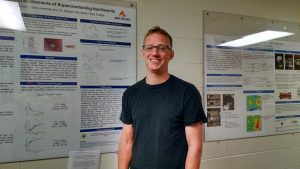 Evidence for Distinct Sources of Superconducting Nonlinearity
Evidence for Distinct Sources of Superconducting Nonlinearity
Research Advisor: Dr. Stephen Remillard
The nonlinear response of cuprate superconducting devices present technological hurdles and scientific opportunities. Intermodulation Distortion (IMD) generated by the nonlinear response is usually undesirable in superconducting devices, however, some devices leverage IMD to their advantage. By analyzing the magnetic relaxation of IMD in a YBa2Cu3O7 (YBCO) superconducting thin film, the effect of magnetic fluxon dynamics on nonlinear response reveals information about the origins of nonlinearity. A carrier wave, resonant with the YBCO superconducting circuit, and two off-resonance probe signals were injected into the resonator. The combination of these three signals locally excited synchronous second and third order IMD (IMD2 and IMD3). Upon removal of an applied static magnetic field, IMD3 relaxed with a single decay mode while IMD2 relaxed with slow and fast decay modes that are temperature dependent. The slow process in the IMD2 decay transitioned from concave down to concave up as the superconductor warmed through an inflection temperature. This temperature dependent transition of decay modality in IMD2 is due to crossing over either the irreversibility line or the surface barrier activation line. IMD2 and IMD3 exhibited unique dependencies on temperature and magnetic field, therefore, even and odd order nonlinearities must result from different physical mechanisms.
This work was supported by grant No. DMR-1505617 from the National Science Foundation.

